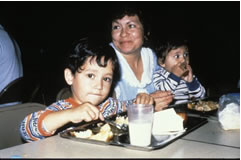
American Obesity Association Fact Sheet

“There are nearly 14 million Hispanic American/Latina women in the United States....While these women currently represent only 11% of the female population of the United States, they are a growing force. By the year 2050, nearly one of every four women in the U.S. will be Hispanic American/Latina.”1 This highlights the fact that the number of Latina women is rising and the problem of obesity is increasing as well.
The following table from the National Women’s Health Information Center 3 shows the percent of overweight and obese women according to race or ethnicity:
| Race/Ethnicity |
Overweight |
Obese |
|---|---|---|
| White (non-Hispanic) |
57.5% | 30.6% |
| African American/Black (non-Hispanic) |
78.0% | 50.8% |
| Mexican American | 71.8% | 40.1% |
| Age adjusted to the U.S. year 2000
standard population. Source: Centers for Disease Control and Prevention, National Center for Health Statistics, National Health and Nutrition Examination Survey, Health, United States, 2002. |
||
A similar table from the American Obesity Association 3 demonstrates the drastic the increase in obesity among U.S. adults aged 20-74 based on race or ethnicity
One of the main reasons for the increase in obesity is the low socioeconomic status of Latina women and Latino families. Professor Alex Stern at the University of Michigan, said that “22% of Latina/os live below the poverty line.”4 This means that there is a large population of Latinas who do not have sufficient funds for food. These families are then forced to buy the cheapest foods, which are not always the healthiest. “Women who are poor and of lower socieconomic status are six times more likely to be obese than women of higher socioeconomic status.” 5
Another reason is genetics. Research suggests that obesity can be inherited from a parent, and when this large number of Latina and minority women are becoming obese, they may be passing this characteristic down to their offspring.6
Along with being obese, a long list of possible diseases are associated with this disease. These effects can be life-threatening. “As of 2002, 8.2% of the Hispanic population have diabetes. It is more common in older Hispanics, with about 25 to 30 percent of Hispanics age 50 or older having the disease. Hispanics are 1.5 times more likely to have diabetes than Whites. And, in 2001 the death rate from diabetes in Hispanics was 40 percent higher than the death rate of Whites.”8 Diabetes is also genetic and children who are obese or overweight are more likely to get diabetes if their parents have it.9
Because of this huge increase in obesity, many organizations have promoted healthier lifestyles for minority women. For example, health claims made by manufacturers and changes in food labeling include:
- Increase the type size for calories
- Provide a percent Daily Value for calories
- Eliminate “calories from fat” listing which takes the emphasis away from “total calories” 10
Another effort to decrease obesity was the creation of a women’s health week. “This national effort
encourages women of all ages to take steps to improve their health. During the week, public and
private organizations and agencies work to raise awareness of key health issues to help women make
healthier choices to improve their lives”11